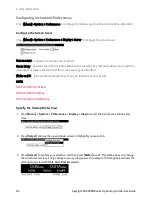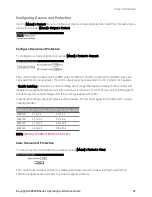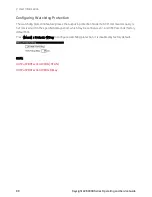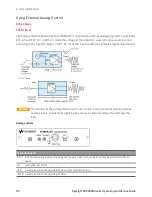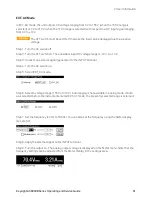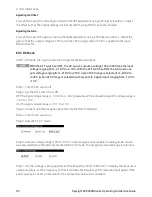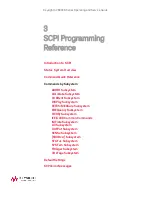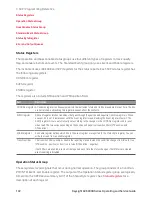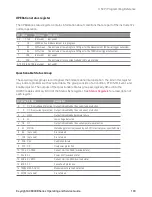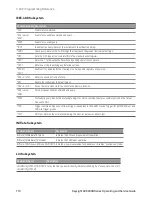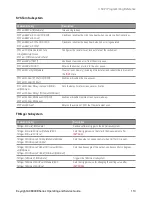
is the same as sending the following commands:
FREQuency 100,90,110
FREQuency:MODE FIXed
You can also combine commands of different subsystems within a message string. In this case, you
must use a colon to return the command parser to the root level in order to access another
subsystem. For example, you could specify the frequency and turn on the output as follows:
FREQuency 100,90,110;:OUTPut ON
The colon after the semicolon returns the command parser to the root.
Terminators
A command string must terminate with a new line (<NL>) character. The IEEE-488 EOI (End-Or-
Identify) message is interpreted as a <NL> character and can be used to terminate a command string
in place of an <NL>. A carriage return followed by a new line (<CR><NL>) is also accepted. Command
string termination always resets the SCPI command path to the root level.
Syntax Conventions
Triangle brackets ( < > ) indicate that a parameter. For example, in the command syntax DISPlay
[:WINDow]:TEXT "<
string
>", the <
string
> parameter is inside triangle brackets. These brackets are not
sent with the command string. For example, you could send DISPlay:WINDow:TEXT "Test in
progress".
A vertical bar ( | ) separates multiple parameter choices for a given command string. For example,
AC|DC|ACDC in the OUTPut:COUPling command indicates that you can specify AC, DC, or ACDC. The
bar is not sent with the command string.
Square brackets ( [ ]) indicate that a keyword or parameter is optional. These brackets are not sent
with the command string. If you do not specify a value for an optional parameter, the instrument
ignores the parameter. In the DISPlay[:WINDow]:TEXT example above, the optional [:WINDow] level
means that DISPlay:TEXT is the same as DISPlay:WINDow:TEXT.
Parameter Types
The SCPI language defines several data formats to be used in commands and queries.
Numeric Parameters
Commands that require numeric parameters will accept all commonly used decimal representations
of numbers including optional signs, decimal points, and scientific notation. If a command accepts only
certain specific values, the instrument will automatically round the input numeric parameters to the
accepted values. The following command requires a numeric parameter for the voltage value:
[SOURce:]CURRent <
value
>|MINimum|MAXimum
3 SCPI Programming Reference
98
Keysight AC6800B Series Operating and Service Guide
Summary of Contents for AC6801B
Page 1: ...Operating and Service Guide Keysight AC6800B Series Basic AC Sources...
Page 16: ...AC6802B 1 Getting Started 16 Keysight AC6800B Series Operating and Service Guide...
Page 17: ...AC6803B Keysight AC6800B Series Operating and Service Guide 17 1 Getting Started...
Page 18: ...AC6804B 1 Getting Started 18 Keysight AC6800B Series Operating and Service Guide...
Page 62: ......
Page 196: ...4 Calibration Verification and Service 196 Keysight AC6800B Series Operating and Service Guide...

